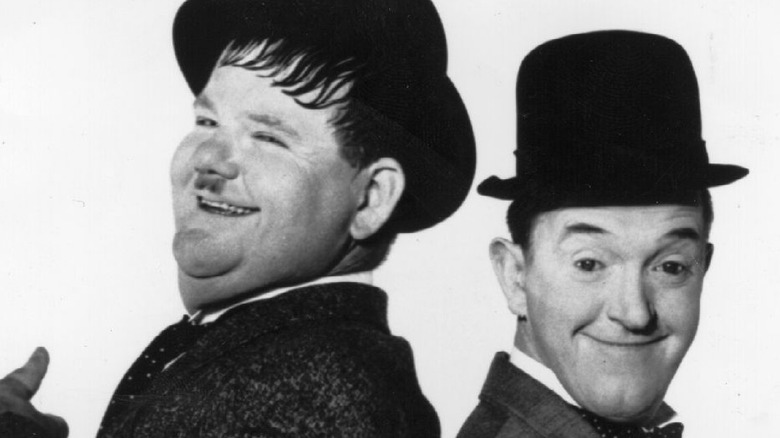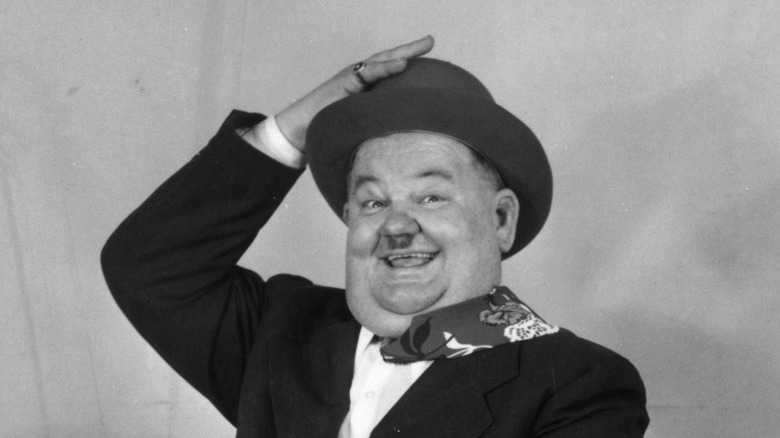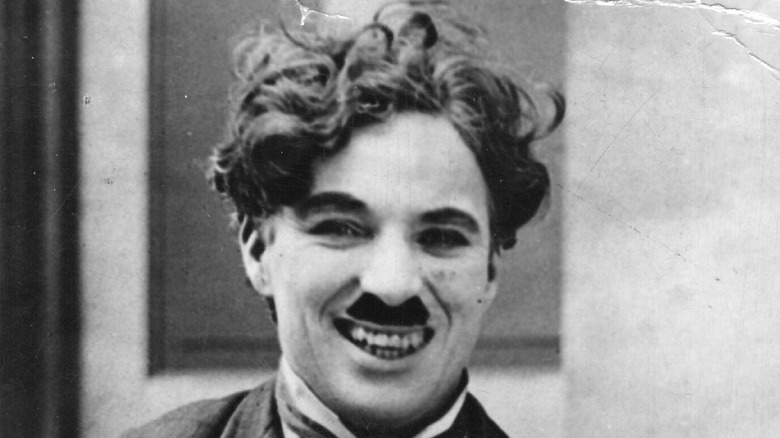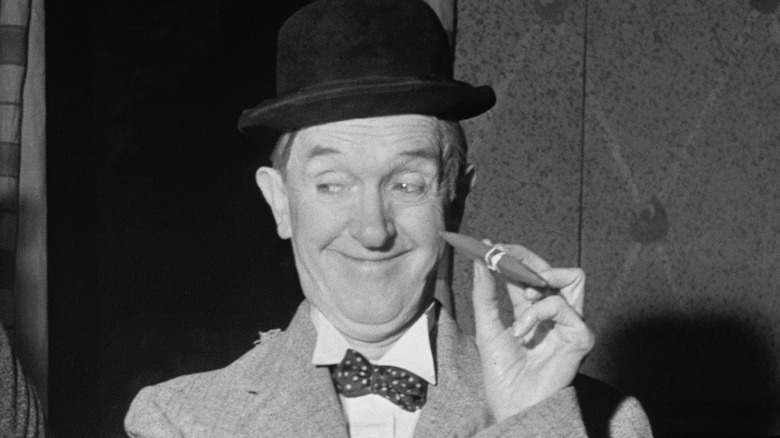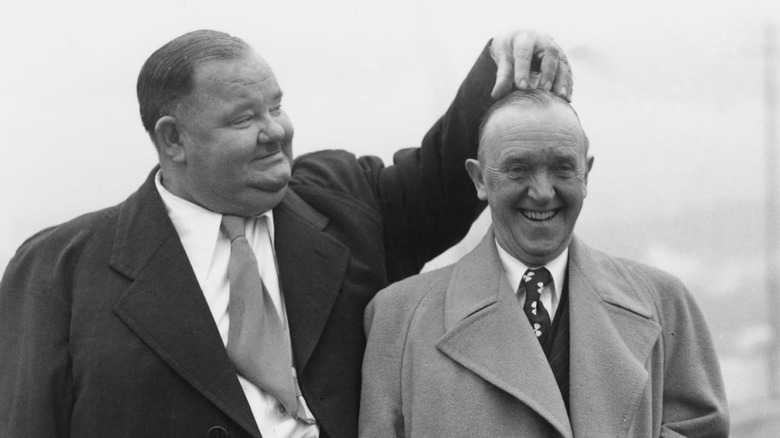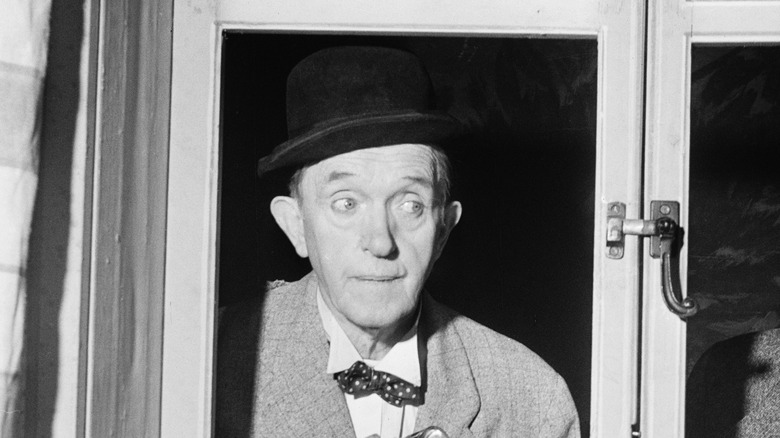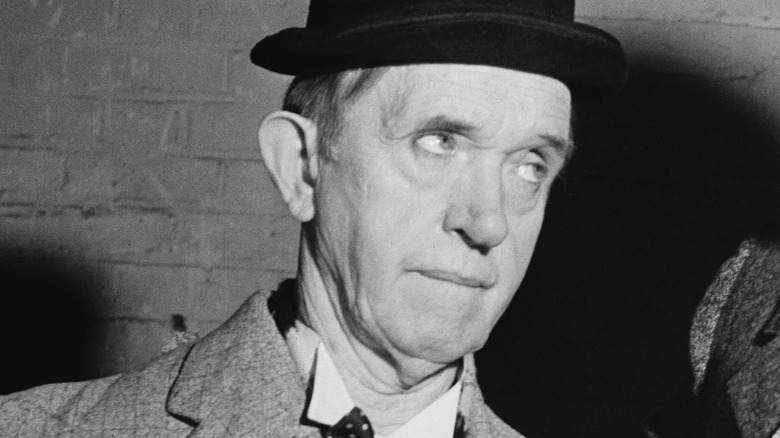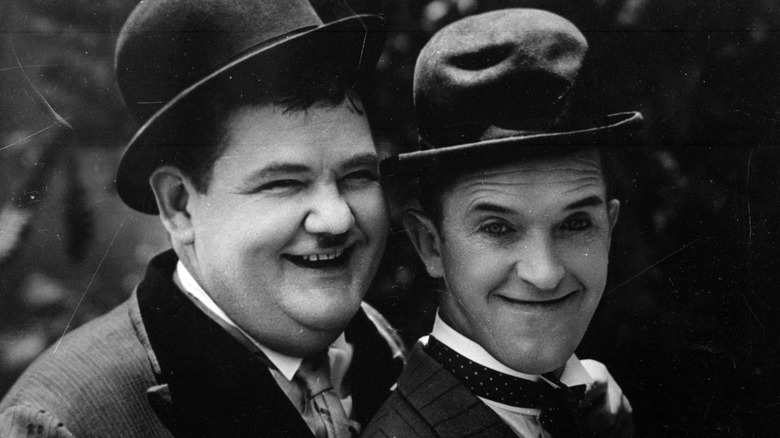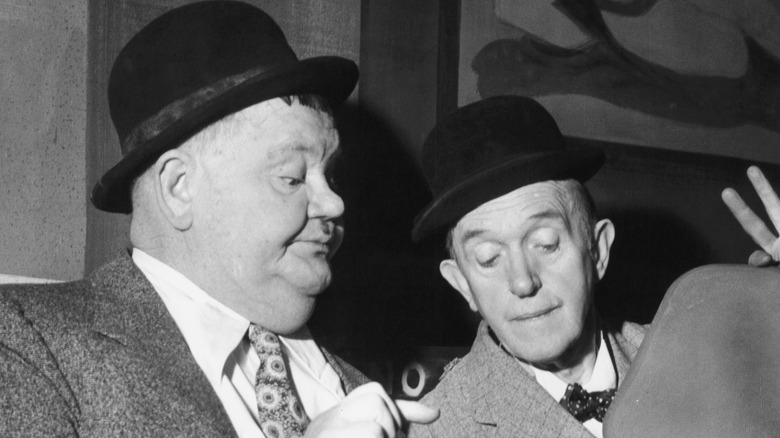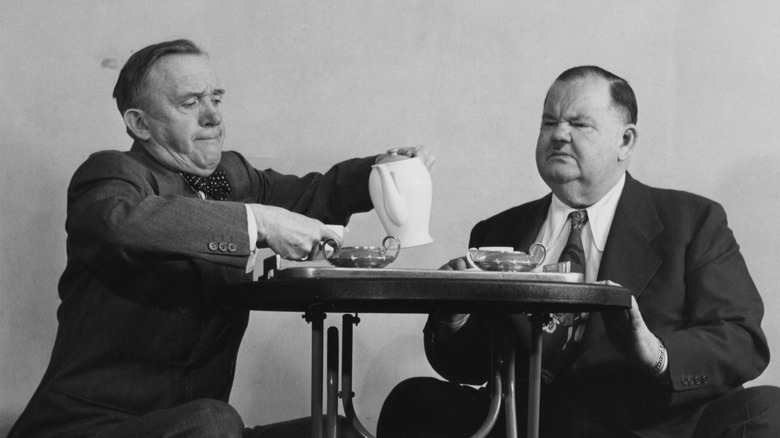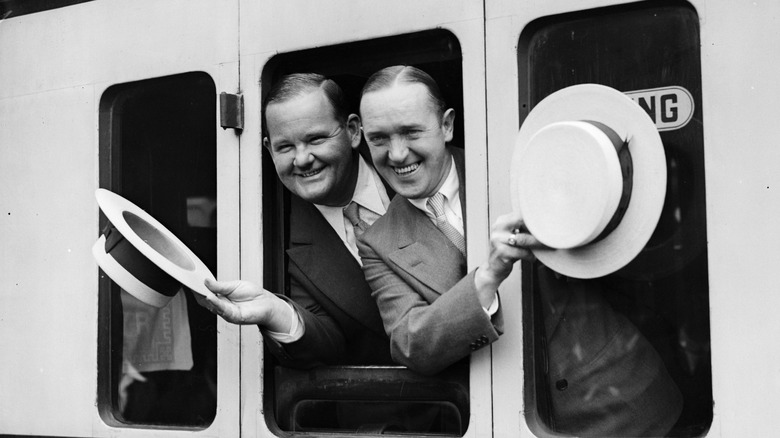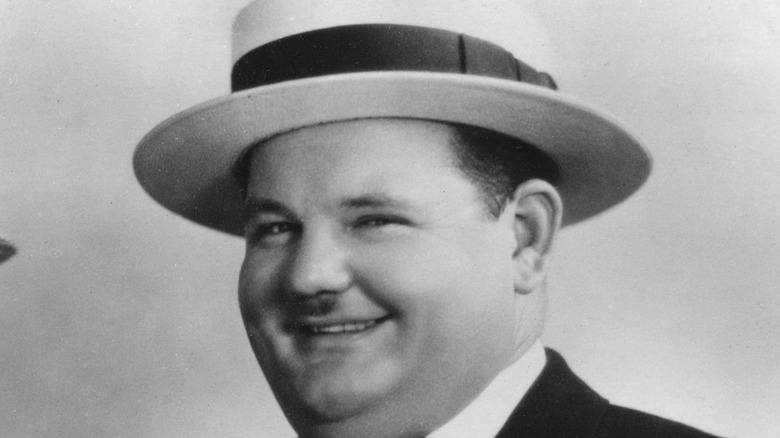The Untold Truth Of Laurel And Hardy
The comedy double act Laurel and Hardy is considered to be among the best, if not the very best, comedy group(s) in history. Like many comedy duos — from Abbott and Costello to Kenan and Kel — the pair found great success in highlighting their real or fictional differences and communicating through conflicts, disagreements, and misunderstandings. The small, ambitious, and British Arthur Stanley Jefferson, better known as Stan Laurel, embodied the tried-and-true role of a fool. The large, smiling, and Southern-American Oliver "Babe" Hardy took on the opposite role of a haughty "straight man."
Laurel and Hardy had individual, and very different, careers in show business before they joined forces in the 1920s, when they were in their thirties. Once they began working together, they forged a comedic partnership that started with short, silent films and led to feature-length films and appearances on TV. They achieved international success throughout the twentieth century, and have since inspired slapstick cartoon characters and generations of comedy double acts. Here's a glimpse into how Laurel and Hardy crossed paths, why they worked so well together, and the setbacks they faced along the way.
Stan Laurel had an English comedy partner before Oliver Hardy
Back in England, Stan Laurel was one half of a pre-Laurel and Hardy comedy duo with a man named Ted Desmond. In 1912, Desmond and Laurel toured the Netherlands and Belgium under the stage name the Barto Brothers, according to The Times. They reportedly dressed as Roman soldiers onstage. But later that same year, Laurel traveled to the United States as part of another comedy troupe, Fred Karno's Army, and the Barto Brothers were no more.
While Laurel found success in Hollywood, Desmond remained in England, where he played in a relatively unknown band and managed arcades, per the Mirror. Still, Desmond did not appear to grow resentful of his old partner's success, and the pair remained friends long after their comedy act dissolved. They continued to correspond via letters and postcards for over 50 years. In 2018, 11 of these articles of correspondence were auctioned off for a total of £4,580, per The Mail.
Stan Laurel started his career touring alongside Charlie Chaplin
When Stan Laurel sailed to New York City to perform with Fred Karno's Army, he shared a cabin with none other than an early-career Charlie Chaplin, who was one of his fellow "Army" members, per HOME. According to Time, Laurel had previously worked as Chaplin's understudy when he lived in England, and continued to do so while they toured North America. In 1913, Chaplin was recruited from the troupe and signed a contract that would launch his international success, according to the University of California Los Angeles. The Karno troupe broke up the following year.
After Chaplin and Laurel went their separate ways and found their respective successes, Laurel continued to talk about Chaplin throughout his life and career, while Chaplin did not mention Laurel in his in-depth autobiography. Years later, television personality Dick Cavett met Laurel and brought up Chaplin's failure to write about him, to which Laurel replied, "I don't deserve to be mentioned in the same sentence with Charlie" (via The New York Times).
Oliver Hardy began his filmmaking career behind the scenes
Oliver Hardy, on the other hand, got his start behind the scenes in the film industry. In 1913, he joined the company Lubin Motion Pictures in Jacksonville, Florida, per News 18. There, he worked on lighting, props, and beyond, and ultimately became a script-clerk. He made his debut on screen the following year, in the 1914 comedy movie "Outwitting Dad." In 1916, he continued to work in Jacksonville at the Vim Southern Studio, where he starred in 35 slapstick films as part of the "Plump and Runt" series, as noted by the Florida Department of State. In 1917, Hardy discovered that some of his colleagues were stealing money from the studio, which ultimately led to the studio's demise.
Hardy later began making movies with Hal Roach, and ultimately signed a contract with Roach's studio. His first Roach film after signing the contract was released the same month that Stan Laurel signed his own contract with Roach in 1925, according to "The Making of Stan Laurel: Echoes of a British Boyhood" by Danny Lawrence. The rest, as they say, is comedy history.
Stan Laurel performed in a vaudeville double act with his first wife
After traveling to the United States to perform as part of the Fred Karno's Army comedy troupe, Laurel decided to stay in the country and try his hand at building a Hollywood career. In 1918, he met Australian singer, dancer, and actress Mae Charlotte Dahlberg, and the pair moved in together and had a 7-year, common-law marriage, according to IMDb. Dahlberg was reportedly responsible for coining the stage surname Laurel after seeing a photo of a Roman general wearing a laurel wreath.
During their relationship, Dahlberg and Laurel performed as a vaudeville act called "Stan and Mae Laurel." In 1921, the duo performed at the Pantages Theater in Spokane, Washington. "Burlesque that oversteps the limits of good taste too often is presented by Stan and Mae Laurel in their old travesty, 'No Mother to Guide Her,'" a local critic wrote for the Spokesman-Review. "Laurel is the liquorish musical hall type of burlesque comedian, clever in his way, and his partner plays straight. The vampire number is overplayed and underdressed."
Stan Laurel and Oliver Hardy each had prolific solo careers before joining forces
By the time he first appeared alongside Oliver Hardy, Stan Laurel had had a relatively prolific showbiz career. His father transformed the attic of their home into a miniature theater when Laurel was 9 years old, per the University of California Los Angeles. The family later moved to Glasgow, Scotland, where Laurel's father managed a full-blown music hall where Laurel first performed in 1906. He signed with Fred Karno's comedy troupe the following year, which led to him moving to the United States in 1915, per the Oxford Dictionary of National Biography.
In the summer of 1917, a former Universal Pictures producer decided to produce several short comedy films, one of which — "Nuts in May" — starred Laurel. An executive named Carl Laemmle was in the audience at the film's premiere, and he invited Laurel to sign a contract with Universal Pictures. By the time Laurel joined Hal Roach's studio, he had worked on 82 films as a solo act, but he reportedly never felt a strong connection with the audience as a solo film star. For his part, Hardy had acted in more than 250 productions prior to joining forces with Laurel, per News 18.
Stan Laurel's eye color caused problems in his early film career
Stan Laurel's eye color almost brought his film career to a screeching halt. He signed with Hal Roach's studios as a potential screen star but was ushered into a behind-the-scenes role when the studio executives saw his eyes on film. "We found out that because of the film at the time — he had very light blue eyes — his eyes wouldn't photograph, so he became a writer," Roach told The Silent Picture in 1970 (via historian Nick Redfern). "And I think for about a year he was a writer at the studio."
Until the 1920s, studios used black-and-white, "blue-blind" Orthochromatic film, per IMDb. In the '20s, Roach studios managed to obtain the newly introduced panchromatic film. "We made a test for him on panchromatic film and found that his eyes now did photograph," Roach told The Silent Picture. "So we put him in a bit [but] he was still a writer."
Laurel's role changed once Roach saw Laurel on screen alongside Oliver Hardy. Based on the pair's onscreen compatibility, the studios began bringing Laurel into more and more film roles. "They seemed to complement each other, so the next one, we gave them a bit more," Roach said. "Here were two funny men that would complement each other, and could play straight to the other one, and I thought that would be a very good thing for comedy."
Stan Laurel butted heads with film producer Hal Roach
Stan Laurel and Oliver Hardy's relationship with Hal Roach's film studio soured in the 1930s. The decade brought about the rise of full-length films, which required larger budgets and therefore more strict parameters. Laurel found that this led to a loss of control over the process of filmmaking as well as the finished results, according to Danny Lawrence's "The Making of Stan Laurel: Echoes of a British Boyhood."
Laurel's decline in agency strained his communications with Roach. According to Lawrence, their conflict intensified during the making of "Babes in Toyland" in 1934, when they clashed over how to bring the story to life. "Roach and Laurel were arguing constantly while it was being made," Henry Brandon, who played the villain in "Babes in Toyland," said. "Roach would tell Laurel his suggestions on the comedy scenes and they'd go into Roach's office and yell at each other. It was a real battle of egos. But Laurel got to do things his way."
Laurel and Hardy ultimately left the Roach Studio for Twentieth-Century Fox in 1941.
Stan Laurel and Oliver Hardy exaggerated their visual differences for comedic effect
In the age of silent film, appearances were everything. Like many others, the success of Stan Laurel and Oliver Hardy's comedy duo hinged on contrast, in looks as well as in personality. The most striking element of visual contrast was the size difference between the two. The large Hardy stood over 6 feet tall, and reportedly weighed close to 300 pounds, per Troy Media. His large size had hindered his chances of becoming a traditional, standalone leading man, but it lent itself significantly to his comedy success alongside the slight Laurel.
According to iNews, Laurel kept his hair long on top, while Hardy pasted his hair flat to his head. Laurel also wore his famous bowler hat a couple of sizes too small so that it perched high atop his head, while Hardy wore a comically oversized bowler hat on his own, according to film writer and Laurel and Hardy historian Tyler St. Mark.
Stan Laurel and Oliver Hardy only appeared on American TV once
In 1954, Stan Laurel and Oliver Hardy headed to a Hollywood hotel to meet up with an old friend. Once they arrived, they realized they had been lured there under false pretenses, and were instead being pushed onto the television show "This Is Your Life" with host Ralph Edwards, according to a 1955 issue of TV Guide (via LaurelandHardy.org). It would be their first live television appearance, and their only one to air in the United States. The duo was more popular overseas, in countries like Germany and Italy, than they were in the U.S.
"It was a staggering experience," Laurel said after appearing on "This Is Your Life," adding, "Babe [Hardy] and I are both great television fans, and we've been planning to do something on TV. But we certainly never intended to start out on an unrehearsed network show!"
Even so, the pair criticized the use of commercial breaks during television broadcasts. "It's a little disturbing to see ourselves on TV now," Laurel said. "We're being used to sell products we've never even heard of, and someone else is making all the money."
Stan Laurel and Oliver Hardy were much different than their characters
While performing as a double act, Stan Laurel and Oliver Hardy played clearly defined, caricatured characters. Laurel was the childlike, incompetent nuisance, routinely pestering and annoying Hardy, while Hardy took on a somewhat stern role akin to a comedic "straight man." Many say that, in real life, they were the opposite: Laurel was the ambitious, diligent hard worker, while Hardy was more easygoing and happy-go-lucky, per iNews.
There was also a disparity between the pair's real-life relationship and that of their characters on stage and screen. As a comedy duo, Laurel and Hardy went together like peanut butter and jelly. But according to the Smithsonian magazine, they were not especially close outside of work. Laurel was reportedly a workaholic who spent every spare minute editing, writing, or generating ideas for future films. Meanwhile, Hardy took his work seriously while he was doing it but spent his free time drinking and gambling.
Stan Laurel stopped acting in films after Oliver Hardy's death
Oliver Hardy died of a massive stroke on August 7, 1957, at the age of 65. Stan Laurel reportedly did not attend his former partner's funeral, saying, "Babe [Hardy's nickname] would understand" (via Time magazine). Despite Laurel's lifelong obsession with film work, he never appeared in another film without Hardy.
In 1955, Laurel suffered a stroke that left him partially paralyzed for the remainder of his life, per the Desert Sun. A decade later, on February 23, 1965, he died of a heart attack at age 74, as reported by the Los Angeles Times. The night before his death, he suffered a heart seizure that was so severe he could not be transported to a hospital. Instead, he was cared for at home by Ralph Downs, the same nurse that had cared for Hardy shortly before his death eight years prior.
Dr. John H. Parrot visited Laurel at home the morning before he died. "It was the first time I'd seen him that he didn't crack some kind of a joke," Parrot told the L.A. Times. "He'd had severe illnesses before, but they never stopped him from joking."
Oliver Hardy partly inspired the character of Homer Simpson
The impact of Stan Laurel and Oliver Hardy lives on in the comedy world decades after they — and their careers — have passed. Many have theorized that their slapstick act influenced the popular cartoon series "The Simpsons." "Wouldn't you say getting hit on the head is a good way to make people laugh?" David Silverman, the show's chief animator, once asked Matt Groenig, the show's creator, according to The Guardian. "Well, hey, we're both fans of Laurel and Hardy," Groenig replied. Oliver Hardy allegedly inspired one of the show's main characters, Homer Simpson, and particularly the character's catchphrase, "D'oh!"
"Hardy did 'D'oh!' a little bit," Groenig told the Guardian, "but really it was [Scottish actor] James Finlayson."
Still, the catchphrase was heavily inspired by Finlayson's performance in the Laurel and Hardy film "Way Out West." "Finlayson has a nice big 'D'oh!' in that [movie]," Groenig said. "Right to the camera ... Yes. That's very crucial."
